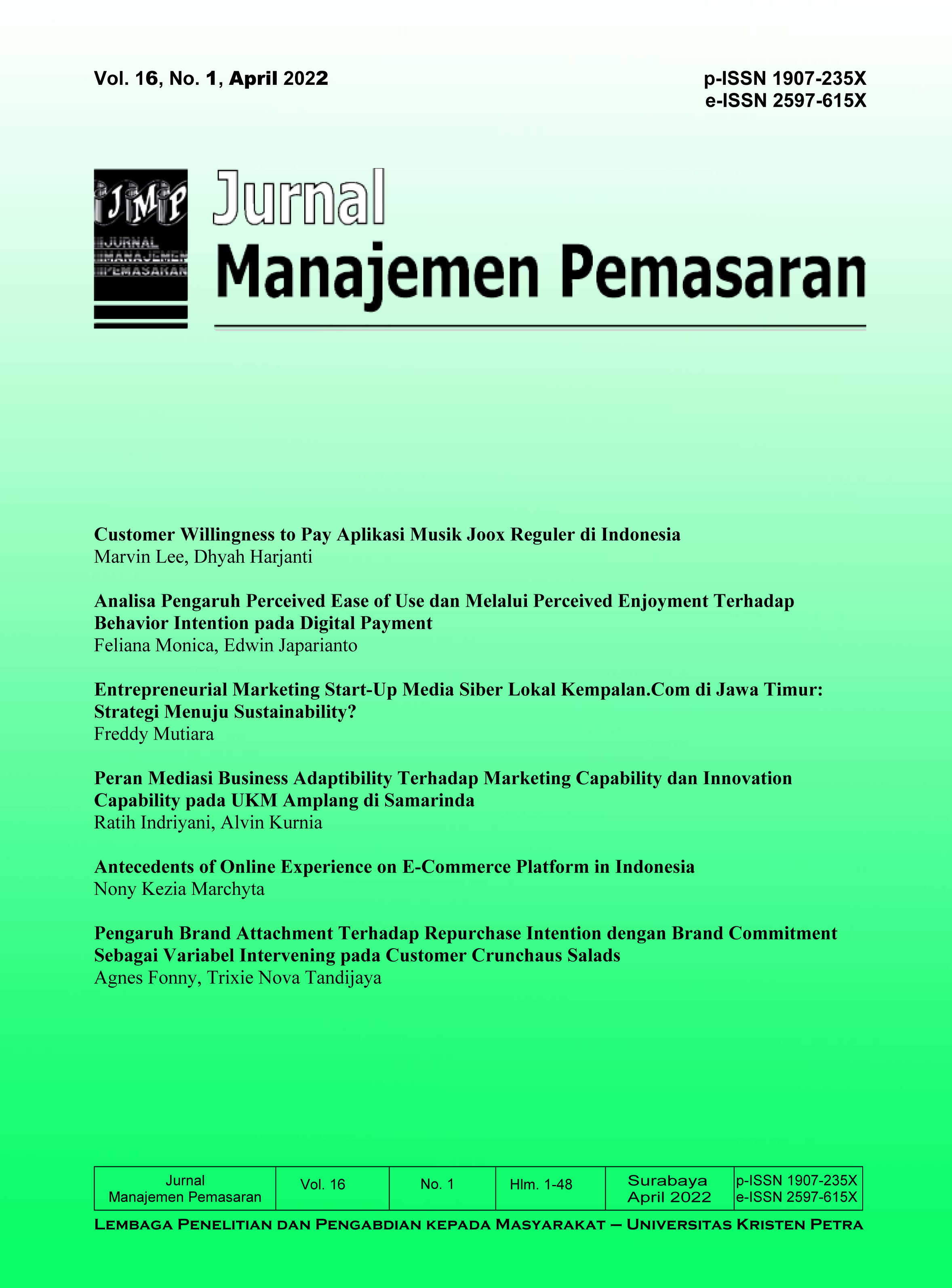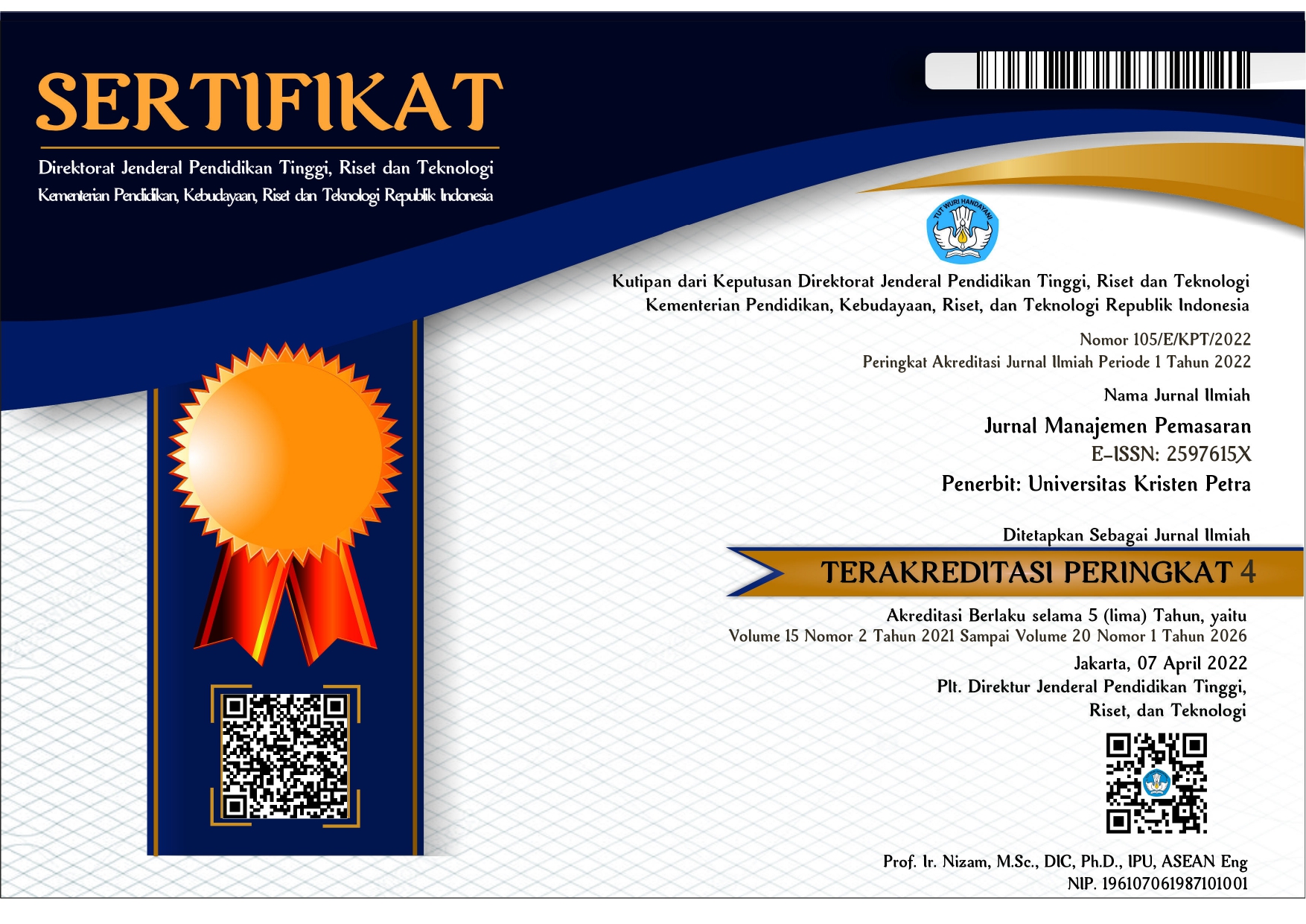ANALISA PENGARUH PERCEIVED EASE OF USE DAN MELALUI PERCEIVED ENJOYMENT TERHADAP BEHAVIOR INTENTION PADA DIGITAL PAYMENT
DOI:
https://doi.org/10.9744/pemasaran.16.1.9-15Keywords:
e-wallet, perceived ease of use, perceived enjoyment, behavior intentionAbstract
The development of information technology in the country of Indonesia continues to experience progress so that the emergence of various breakthroughs in the financial sector. Electronic payment facilities (e-wallet) as one of the developments in the field of financial technology has experienced a rapid increase and is a trend for the people of Indonesia. The various conveniences offered to make everyone very dependent on technology, so e-wallet applications have become a basic necessity for everyone. This study aims to analyze the effect of perceived ease of use on behavioral intention through perceived enjoyment as an intervening variable on digital payments. The final results obtained in this study indicate that perceived ease of use has a positive effect on behavioral intention, perceived ease of use also has a positive effect on perceived enjoyment, as well as perceived enjoyment has a positive effect on behavior intention.
Abstrak:
Perkembangan teknologi informasi di negara Indonesia terus mengalami kemajuan sehingga munculnya berbagai terobosan baru di bidang finansial. Sarana pembayaran elektronik (e-wallet) sebagai salah satu perkembangan di bidang financial technology telah mengalami peningkatan pesat dan menjadi kecenderungan bagi masyarakat Indonesia. Berbagai kemudahan yang ditawarkan membuat semua orang sangat bergantung pada teknologi, sehingga aplikasi-aplikasi e-wallet sudah menjadi kebutuhan dasar untuk semua orang. Penelitian ini bertujuan untuk menganalisa pengaruh dari perceived ease of use terhadap behavior intention melalui perceived enjoyment sebagai variabel intervening pada digital payment. Hasil akhir yang diperoleh dalam penelitian ini menunjukkan bahwa perceived ease of use memiliki pengaruh yang positif terhadap behavior intention, perceived ease of use juga memiliki pengaruh yang positif terhadap perceived enjoyment, begitu juga dengan perceived enjoyment memiliki pengaruh yang positif terhadap behavior intention.
References
Aaron, M., Rivadeneyra, F., & Sohal, S. (2017). Fintech: Is This Time Different? A Framework for Assessing Risks and Opportunities for Central Banks.
Abdillah, W., & Hartono, J. (2015). Partial least square (PLS) – Alternatif Structural Equation Modeling (SEM) dalam Penelitian Bisnis (cetakan 1). Yogyakarta: Penerbit Andy.
Anggraeni, R. (2015). Pengaruh Persepsi Kemudahan Penggunaan dan Persepsi Kegunaan Terhadap Niat Untuk Menggunakan dan Penggunaan Aktual Layanan Jejaring Sosial Berbasis Lokasi (Studi pada Mahasiswa Fakultas Ekonomi dan Bisnis Universitas Brawijaya Malang), 44–52.
Chin, L. P., & Ahmad, Z. A. (2015). Perceived Enjoy-ment and Malaysian Consumers’ Intention to Use a Single Platform E-Payment, 9.
Chiu, C., & Wang, E. T. G. (2008). Information & Management Understanding Web-based learning continuance intention: The role of subjective task value, 45, 194–201. https://doi.org/10.1016/ j.im.2008.02.003
Churchill, G. A. (2005). Dasar-dasar riset pemasaran jilid 1 Ed. 4. Jakarta: Erlangga.
Davis, F. D. (1989). Perceived Usefulness, Perceived Ease of Use, and User Acceptance of Information Technology, 13(3), 319–340.
Fishbein, M. & Ajzen, Icek. (1975). Belief, attitude, intention and behaviour: An introduction to theory and research.
Fred, D., & Davis, B. F. D. (1989). Perceived Useful-ness, Perceived Ease of Use and User Acceptance of Information Technology, (September), 319–340.
Halevi, T., Ma, D., Saxena, N., & Xiang, T. (2012). Secure Proximity Detection for NFC Devices based on Ambient Sensor Data, 1–18.
Hansen, J. M., Saridakis, G., Benson, V., Hansen, J. M., & Saridakis, G. (2017). Risk, Trust, and the Interaction of Perceived Ease of Use and Behavioral Control in Predicting Consumers’ Use of Social Media for Transactions. Computers in Human Behavior. https://doi.org/10.1016/j.chb.2017.11.010
Heijden, H. Van Der, Verhagen, T., & Creemers, M. (2003). Understanding Online purchase inten-tions: contributions from technology and trust perspectives, (July), 41–48. https://doi.org/10.1057/palgrave.ejis.3000445
Ilovelife.id (2016). Atur Transaksi Cashless Agar Tak Jadi Less Cash. Retrieved from https://ilovelife.co.id/blog/atur-transaksi-cashless-agar-tak-jadi-less-cash/
Intarot, P. (2018). Influencing Factor in E-Wallet Acceptant and Use, 4(4), 167-175.
Koenig-lewis, N., Marquet, M., & Palmer, A. (2015). Enjoyment and social influence: predicting mo-bile payment adoption, (May), 37–41. https://doi.org/10.1080/02642069.2015.1043278
Komite.id (2016). Komite APJII Rilis Survei Pengguna Internet Indonesia. Retrieved from https://www.komite.id/wp-content/uploads/2016/11/apjii-rilis-survei-pengguna-internet-indonesia-ytx9a0PFKQ.jpg
Kompas.com (2018). Wah Siswa Indonesia pemakai Teknologi Tertinggi Dunia! Ini 7 Faktanya. Retrieved from https://edukasi.kompas.com/read/2018/12/11/08143651/wah-siswa-indonesia-pemakai-teknologi-tertinggi-dunia-ini-7-faktanya?page=all
Li, Y. (2016). Empirical Study of Influential Factors of Online Customers’ Repurchase Intention, 48–60. https://doi.org/10.4236/ib.2016.83006
Maarop, N., Jamaludin, R., Samy, G. N., Magalingam, P., Hassan, N. H., Ten, W. H., Technology, A. (2018). Correlation Analysis Between Factors Influencing the Usage Intention of NFC Mobile Wallet Payment, 215-227. https://doi.org/http://dx.doi.org/10.4314/jfas.v10i2s.18
Moon, J., & Kim, Y. (2001). Extending the TAM for a World-Wide-Web context, 38(December).
Mubuke, F. (2017). The Predictability of Perceived Enjoyment and Its Impact on the Intention to Use Mobile Learning Systems, (March).
Rodrigues, L. F., Oliveira, A., & Costa, C. J. (2016). Computers in Human Behavior Does ease-of-use contributes to the perception of enjoyment? A case of gamification in e-banking. Computers in Human Behavior, 61, 114–126. https://doi.org/10.1016/j.chb.2016.03.015
Rouibah, K., Lowry, P. B., & Hwang, Y. (2016). The effects of perceived enjoyment and perceived risks on trust formation and intentions to use online payment systems: New perspectives from an Arab country. Electronic Commerce Research and Applications. https://doi.org/10.1016/j.elerap.2016.07.001
Singh, S., & Srivastava, R. K. (2018). Predicting the Intention to Use Mobile Banking in India Introduction.
Venkatesh, V., Thong, J. Y. L., & Xu, X. (2012). Con-sumer Acceptance and Use of Information Technology: Extending the Unified Theory of Acceptance and Use of Technology, 157-178.
Wahdi, M. (2011). Riset Pemasaran: Teori dan Apli-kasi untuk Pengambilan Keputusan. cet. 1. Jakar-ta: CAPS (center for academic publishing ser-vice).
Zeithaml, V. A., Berry, L. L., & Parasuraman, A. (1996). The Behavioral Consequences of Service Quality, 60(2), 31–46.

















